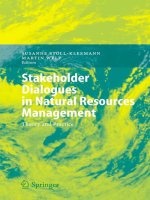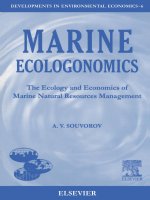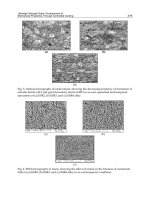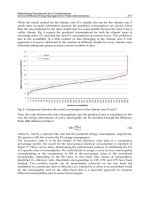Sustainable Natural Resources Management Part 12 docx
Bạn đang xem bản rút gọn của tài liệu. Xem và tải ngay bản đầy đủ của tài liệu tại đây (1.31 MB, 14 trang )
An Analysis of the Contribution of Community
Wildlife Management Areas on Livelihood in Tanzania
143
4.4 Data analyses
Most of the collected data were of qualitative nature and necessitated use of qualitative data
analysis. In addition SPSS software was used in the analysis particularly data from
household questionnaires. As for KAP data, the data were completely qualitative in nature
and this necessitated the use of qualitative data analysis – intellectual interpretation which
was later supported with collected data from WMA stakeholders.
5. Results and discussion
5.1 Socio - economic profile of the respondents
The socio-economic characteristics of the population sample for the surveyed villages are
presented in Table 1 below. Males formed more than two-third of the respondents and
about 87% of the subjects were between 18 and 54 years of age. As for education, more than
90% had primary school education. This scenario indicates that illiteracy level is high.
Village N Gender (%) Age category (%) Education (%)
M F 18-34 35-54 >54 NF PR SS
Minjingu 31 70 30 20 57 23 6 87 7
Vilima
Vitatu
29 63 37 31 52 17 7 86 7
Mwada 29 72 28 21 79 0 4 86 10
Total 89 205 95 72 188 40 17 259 24
Average 29.7 68.3 31.7 24 62.7 13.3 5.7 86.3 8
Source: Field data, 2007 N=sample size M=male F=female NF=non-formal PR=primary education
SS=secondary education
Table 1. Socio-economic characteristics of the study villages
5.2 Status of WMA economic ventures and its contribution to people’s livelihood
In this study several ventures such as tented camps, photographic safaris, hunting enterprises,
lodges etc. were identified (See Table 2). What can be deduced from these results is that all
investments are owned by investors from outside the villages forming the WMA.
Village Name of economic venture
Owner
(native or
non-native)
Mwada
Kibo safari (Oridoy tented lodge), Northern hunting
enterprises,
Non-native
Minjingu
Tarangire River camp, Maramboi tented lodge,
Paradise campsite, Roika lodge
Non-native
Vilima Vitatu
Kibo photographic safaris, Northern hunting
enterprises (Shein), Maramboi tented lodge
Non-native
Table 2. Economic ventures within the WMA
Sustainable Natural Resources Management
144
According to field data, between 2007 and 2010, a total of TZS 137,700,704 (US $ 137,700)
(See Table 3 ) were realised from different sources mainly photographic safari, hunting
(domestic and tourist), fishing, levy, lodges, and fines. Overall, income over years shows
an increasing trend, the highest of about 32% recorded between 2008 and 2009. The
increase between 2009 and 201o was 4%. Overall average income increase between 2007
and 2010 was 28%. Considering the overall income realised, the 11 villages forming the
WMA (revenue divided equally among villages), the average village population of 3,000
people and average family size of 5 people; individuals and households realised TZS 4,173
(US $ 4.1) and TZS 20, 865 (US $ 20.9) per annum respectively. By all standards this
contribution is insignificant if local communities are to use the income as an incentive to
conserve.
Source of income
(TZS)
2007 2008 2009 2010
Lake Burunge
Tented Lodge
0 2,260,000 2,680,000 3,220,000
Maramboi Lodge 0 2,260,000 2,680,000 3,220,000
Uni Afrique
Lodge
0 1,080,000 1,670,000 2,080,000
Others (non
lodge)
91,374 0 3,600,000 5,400,000
Tourist hunting 13,389,555 13,389,555 14,,500,000 13,389,555
Fishing 315,000 6,000,000 7,600,000 6,000,000
Domestic hunting 0 1,200,000 1,800,000 2,600,000
Land rent 5,00,000 0 0 0
Photographic
safari
21,675,665 0 0 0
Fines 0 100,000 200,000 300,000
TOTAL 40, 471,594 26,289,555 34,730,000 36,209,555
Table 3. WMA realized income between 2007 and 2010
A study by Magiri (2011) in Ikoma-Natta (IKONA) WMA, revealed a significant income
contribution of the initiative. Between 2007 and 2010, the WMA realized TZS 207,502,407
(US $ 207,500). The five villages forming the WMA each received TZS 41 million (US $
41,000). Taking into account the average family size of 4 people and the village population
of 2,500 people, individuals and households were able to realize TZS 16,400 (US $ 16.4) and
65,600 (US $ 65.6) respectively. This income was four times more than that which was
realized by Burunge WMA.
Despite the low income contribution by Burunge WMA, the potential for increased revenue
is potentially high. This can be achieved through improving contracts between investors and
WMA; capacity building in enterprise management, book keeping, resource inventory and
monitoring, village game scout training, and improvement of tourism facilities. Currently
the AWF is constructing tourist centre (See Fig. 1).
An Analysis of the Contribution of Community
Wildlife Management Areas on Livelihood in Tanzania
145
Fig. 1. Burunge Tourist Centre under costruction. Photo by Gerson Mollel, 2011
Sustainable Natural Resources Management
146
5.3 Local people’s perception on benefits
Local communities were asked as to whether they are aware of the use of revenues paid to the
WMA by investors and its uses in socio-economic development at village level. Results
indicate that the funds were mainly used for provision of social services (construction of
classrooms, dispensary and village government offices), payment for allowances to WMA staff
during meetings and seminars, bursary to students, and in supplementing to village
government revenues (See Table 4). On the other hand, different organizations and/or
individuals made several indirect contributions. For example, AWF provided a motorbike, 16
pieces of desktop computers, constructed an office and installed electricity in the office. The
organization also trained WMA officials, village councilors and VGS on different management
aspects. However, due Babati District Council interference on WMA’s management a motor-
bike and computers were sent to the district headquarters for use by district officials.
Type of project Investor’s
name
Take-off year
Construction of 3 classrooms (Nkaiti Secondary
School) and desalinization of water – Minjingu village
Roika 2005
Construction of village government house at Vilima
Vitatu (Mdori) village
Kibo safaris 2006/07
Capacity building (training of WMA officials,
councilors and VGS) – on enterprise management,
security and resources management
AWF 2007
Provision of I motorbike and 16 pieces of computers
to Vilima Vitatu
USAID 2007
Education sponsorship for 2 students (secondary
education)
Northern
Hunting
2007
VGS= Village Game Scouts
Table 4. Social development projects initiated by investors within the WMA
Community-based conservation (CBC) benefit sharing schemes in the Tanzania shows
mixed results. For example, between 1992 and 2003, Serengeti National Park (SNP)
generated US $ 31 million from tourism but only 1.6% was allocated to adjacent villages for
socio-economic development projects (Kideghesho & Mokiti, 2003). Instead, a substantial
amount was allocated to law enforcement (ibid.). Emerton & Mfunda (1999) in their studies
in Western Serengeti; found that an individual household got an average of US $ 2.5 per
year from benefit sharing received indirectly through implementation of development
projects. A study by Kaswamila (2003) in 10 villages adjacent to Kilimanjaro National Park,
on the impact of Support for Community Initiated Project (SCIP), revealed that between
1994 and 2001 about US $ 213, 000 was spent on socio-economic development projects in
four districts (Moshi Rural, Rombo, Hai & Monduli). However, several weaknesses were
observed: 70% of the projects were not priority projects to local communities; there were
imbalances in fund allocation; and there was nepotism in disbursement of funds and lack of
criteria in allocating funds to villages (ibid.). Where decision-making has been devolved to
local people, however, for example through eco-tourism, it has been shown to deliver
tangible benefits relative to “top-down” projects (e.g. hunting concessions).
An Analysis of the Contribution of Community
Wildlife Management Areas on Livelihood in Tanzania
147
In Sinya (Monduli District), located within the Greater Amboseli Ecosystem (Tanzania part),
agreement between the village and a local eco-tourism company has led to increase of
tourism income generated from bed-night fees. The income increased rapidly during the
five years from 1999-2003, from US $ 5,000 to $ 19,000 (ibid.). The income has been used for
conventional social service infrastructure priorities, notably construction of the primary
school dormitory and maintenance of water supply machinery (ibid.). Nonetheless, while
some revenue has clearly been invested in socially valuable community projects, much of
the revenue has not been used well (ibid.).
In Engare Sero (Ngorongoro District), the village hosts two campsites belonging to one tour
foreign operator and a modest tented lodge belonging to another operator. But unlike in
Sinya or Ololosokwan, neither of these developments had a contractual agreement between
the tourist company and the village (Nelson, 2004). A company granted title by the village
purchased land for the lodge outright, and the land for the two campsites was apparently
settled and developed without any local authorization (ibid.). The owner of the two
campsites pays nothing to the village while the tented camp pays a US $ 5 bed-night fee,
considerably less than most villages in the region earn. As a result the village has little stake
in income produced by increasing number of tourists (ibid.). Estimates of earnings is
estimated at US $ 2,500 annually from payments made by lodge, only 5 to10% of that earned
through tourism by Sinya or Ololosokwan (ibid.).
The preceding discussion has shown that where local people obtain tangible benefits, these
act as an incentive to conservation initiatives and vice versa. Also, community-partnership
projects are better placed to trickle down benefits to local people. What is important is to
devolve power to lower levels (local people). What the people need is to be equipped with
enterprise management skills and clear and transparent contractual agreements. In the case
of Burunge WMA the possible strategies to achieve a win-win situation could include
capacity building to WMA staff (in enterprise management, contract negotiations and
wildlife management); transparency in the use of realised funds; share of revenues among
villages to consider status of human wildlife conflicts and richness of wildlife; and ensuring
that investors are accountable to the WMA council and village leadership and not the
district council as it now.
Village Company Employees Male Female
Minjingu Maramboi lodge 8 8 0
Tarangire River
Campsite
6 6 0
Northern
hunting
10 10 0
Paradise
campsite
3 2 1
Kibo safaris 4 4 0
Vilima Vitatu Kibo safaris 1 1 0
Northern
hunting
3 3 0
Maramboi lodge 4 4 0
Total 39 38 1
Table 5. Employment status of local communities within the Burunge WMA
Sustainable Natural Resources Management
148
5.4 Employment by investment companies
Study results indicate that a total of 39 people were employed (permanent and casual) by
seven investment companies as cooks and security guards in Minjingu and Vilima Vitatu
(See Table 5). Of these employees, 97% were males with an average monthly wage of TZS.
90,000. Out of the total employees 50% come from villages forming Burunge WMA. The
gains from employment in one way or another plays a role in poverty alleviation at
household level. In addition, the presence of the WMA has made it possible to recruit some
local communities in different ways. For example, the WMA in 2008 recruited an office
attendant on permanent basis and is currently paying WMA officials and VGS allowances.
VGS allowances are valued at TZS 50,000 (US $ 50) per month.
5.5 General impacts of WMA on livelihood
Local communities were asked to mention both positive and negative impacts of Burunge
WMA. Perceived positive included employment, transport assistance to needy people,
contribution towards overall village income, conservation, reduced poaching, bursary to
students and provision of social services. However, in Minjingu most respondents could not
see any positive impact. The non-appreciation of the contribution of WMA in Minjingu
could probably be explained by the fact that the village has already submitted her intention
to withdrawal from the WMA since 2007.
When asked to mention WMA negative impacts they identified loss of land, poor
relationship with WMA staff, resource use restrictions and failure to pay salaries in time.
Other negative impacts were increased land use conflicts, trypanosomiasis infection to
livestock (Tsetse fly), crop and livestock depredation by wild animals, and deforestation for
firewood, charcoal (See Fig. 3), timber for house construction and for medicinal purposes.
All these can be described as costs associated with WMA establishment.
Fig. 3. Charcoal furnace within WMA. Photo by Author, 2007
An Analysis of the Contribution of Community
Wildlife Management Areas on Livelihood in Tanzania
149
5.6 Constraints associated with establishment of WMA
The identified costs can be categorized into four main groups i.e. human-wildlife conflicts,
land-use conflicts, denial of use of forest, non-forest products, environmental degradation
and land scarcity. Human-wildlife Conflicts (HWCs) is a significant and growing
conservation problem around the world, the direct and indirect costs of wildlife (i.e. damage
to crops, livestock, human lives) provide incentives for rural people to kill wildlife and
reduce the quantity and quality of wildlife habitats (Nyhus et al., 2005; Thirgood, 2005).
Similar situation was observed in the study area. During PRA session youths in Vilima
Vitatu HWC identified crop raids, diseases transmission from wildlife to livestock as
constraint to local communities and that if not checked antagonism between
conservationists and local communities will escalate.
Land-use conflicts was also aired as a cost particularly between nomadic Barabaig and
farmers during pasture stress periods (dry season); investors and livestock keepers for
grazing land; livestock keepers and farmers over cattle paths-normally in crop land - tense
during wet season; and between conservationists (e.g. Tarangire National Park) and local
communities over boundaries. Local communities have been complaining for a long time
now that Tarangire National Park has taken part of their land particularly the gemstone rich
Sarame Mountain. A win-win situation can only be achieved if these conflicts are addressed.
Denial to harvest forest and non-forest products from the WMA was also seen as a cost. The
village by-laws prohibit local communities to enter into the conserved area without
permission from the village government. This has made local communities unable to freely
access forest (poles, timber, charcoal etc.) and non-forest (grass, honey, wildlife etc.) as they
used to do before the area attained the WMA status. Denial of local communities to harvest
forest products has accelerated deforestation in areas outside the WMA. This is due to the
fact that firewood is the only source of domestic energy and the only place to fell trees are
those outside the WMA. In addressing the problem of resource access within the WMA, the
village governments should set aside special days to allow local communities to harvest
dead trees and/or medicinal plants under the supervision of VGS. A long-term solution is to
advocate the establishment of community forests in each village or households to have
forest lots around their farms which could save the multi-purpose role of provision of
firewood/timber and also act as farm boundaries. During the field study deforestation
through clearing of land for construction of investors sites (residential, business premises,
infrastructure development, and firewood - as source of domestic energy) were evident.
In addition, the establishment of WMA led to loss of agricultural and/or grazing land.
However, the losses of land were on unequal proportion. For example, among the eleven
villages forming the WMA, Vilima Vitatu, Sangaiwe and Mwada lost 65%, 27% and 19% of
their total land respectively. The livelihood implication for this loss is the decline in both
cash income and in crop production.
5.7 Importance of WMA relative to other institutions in people’s livelihood
In focusing what the WMA means to the local people a Venn diagram as a PRA tool was
used to rank various institutions against their role(s) in contributing to people’s livelihood.
Sustainable Natural Resources Management
150
Results from Vilima Vitatu village which involved three groups of people (youths, adults,
elders) indicate that WMA as an institution was lowly ranked relative to other institutions
(See Tables). The WMA was rated fourth by elders, 6
th
by youths and could not be
mentioned (had no role) by adults. This suggests that the role of the WMA in improving
people’s standard of living is still unclear. The institutions with impacts in order of
importance were schools, churches and mosques. The possible reasons for ranking high
these institutions could be the quality of services provided by these institutions which
trickle down to individuals or households.
Elders Adults Youths
1. Primary school
2. Dispensary
3. Church/mosque
4. Burunge WMA-two students sponsored in
2007 (form 1 to 6), school construction and
teaching aids/equipment
5. NGOs (Land Management Program
(savings and credit services); Farm Africa
(savings and credits/improved livestock
credit); Participatory Agriculture
Development Project (PADEP) – agriculture
development and savings and credits e.g.
Village Cooperative Banks (VICOBA),
SACCOS and livestock production/keeping
6. Mweka camp (security and environmental
education)
1. Primary school
2. Dispensary
3. Church/mosque
4. Mweka camp
1. Primary school
2. Church/mosque
3. Water sources
4. Dispensary
5. Burunge WMA
6. Mweka camp
7. Hunting block
Source: Field data (2008)
Table 6. Perceived Institutional ranking in Vilima Vitatu
Different reasons were given as to why for example school, dispensary and churches and/or
mosques ranked high. This ranking shows how they perceive education as a very important
tool in combating poverty indirectly. For the dispensary, it is for its crucial role in saving
people’s lives while churches and/or mosques are crucial in reducing or avoiding sinful
behaviours.
5.8 Suggestions to make WMA effective and sustainable
Local communities and WMA leaders were further probed on mechanisms required to be in
place to make Burunge WMA effective and sustainable. The most important suggestions
given include improved relationship among investors, local communities and WMA staff,
the need to involve local communities in major decisions affecting their livelihood,
improvement of business contracts, need for investors to follow village rules and regulation,
awareness education and empowerment of local communities in running Burunge WMA
(See Table 7).
An Analysis of the Contribution of Community
Wildlife Management Areas on Livelihood in Tanzania
151
Suggestions
Minjingu
(n=31)
Vilima Vitatu
(n=29)
Mwada (n=29)
Follow rules and regulations 40 0 0
Gender discrimination in
employment
7 0 0
Improve cooperation 48 14 5
Increase salaries 5 0 0
Involve locals in decision making 0 34 10
Improved contracts 0 38 40
WMA management under village
government
0 9 10
Employ youths and locals 0 5 5
Awareness education 0 0 10
Improve VGS allowances 0 0 10
New land use plan 0 0 10
Table 7. Suggestions to make BurungeWMA sustainable
Generic suggestions to enable Burunge WMA to become sustainable include improvement
of relationship among WMA main stakeholders at village level, i.e. local communities,
investors, and WMA staff; involvement local communities in major issues affecting their day
to day life; WMA management to be under village management committees; and slack
contract agreements. Furthermore, they suggested that efforts should be made to ensure that
income trickle down to household and/or individual level. One local community said: “I
don’t have children and therefore I don’t benefit from the WMA and therefore I don’t have an
incentive to conserve”. What can be deduced from this statement is that, it is only when
households or individuals benefit that local communities are likely to conserve. Others
could be increased employment of local communities by WMA investors particularly for
jobs which don’t demand high skills. A provision need to be in place in Memorandum of
Understandings (MoUs) or contracts specifying this requirement.
As for contract, the investor among others is required to promote the WMA, to ensure that
60% of the employees come from villages forming the WMA, and to provide social services
to villages forming the WMA. In addition, EIA is mandatory before take-off of any
development project, investor has to address soil and water conservation and/or conserve
the areas ecology and payment of deposit a certain amount of money (in dollars) as a
collateral depending on the amount of money invested. However, the collateral value is not
indicated. Other requirements are: contract duration of three years and termination of
contract requires 3 months notice. Most of these requirements have not been fulfilled by the
investors. Another technical weakness is on signing of the agreement. The District Game
Officer has been signing contracts on behalf of the WMA. It is suggested that signatories
should come from the WMA management and should be written in a user-friendly language
(Kiswahili) instead of English which requires a certain level of education. About 94% of the
populations in the study area have informal and primary school education.
Sustainable Natural Resources Management
152
When one of the investor was asked to comment on the contract he had this to say:
“The duration of the contract (of 3 years) is too short as it exposes the investor in risk particularly in
a situation where the WMA decides to terminate the contract. Again a three month notice for
terminating an agreement is too short”.
As a way forward to make the WMA sustainable, the WMA leaders pleaded for the
government and other actors to assist in training WMA management in contracts and
contract management and for the government to devolve power to the WMA in running
their day to day activities. “we could not have lost our computers and a motor-bike had we
been free from interference from above” lamented one of the WMA staff who preferred
anonymity. The other area requiring immediate attention is paramilitary training to Village
Game Scouts (VGS) and availability of patrol gears particularly guns, motor-bikes and/or
bicycles. The number of trained VGS is currently nine. This number is very low compared to
the WMA coverage of 280 km
2
implying a VGS-Area ratio of 1: 31 km
2
which is extremely
very low. Due to lack of reliable transport, they bank on transport provided by Tarangire
National Park and/or hired bicycles.
6. Conclusion and recommendations
After almost five years of operation (2006-2011) the WMA has shown a great potential
towards improving local peoples livelihood, ecological conservation, and biodiversity
conservation in the study area. However, despite the observed successes, the initiative still
has numerous challenges such as lack of transparency in revenue uses, slack contracts, non-
empowerment of local communities in decision-making, and absence of regulations and
implementation strategies to operationalise the new 2009 wildlife Act.
The study recommends:
The need for having in place WMA regulations and implementation strategy
Devolving power to local communities to address issues and problems of WMAs
The need for waging awareness education on the importance of the WMA for both
conservation and development
Initial capital investment to WMAs to assist in resources inventory and in human
resources capacity development. This can be done by the District Councils, Tanzania
National Parks (TANAPA), Ngorongoro Conservation Area Authority (NCAA), NGOs
(local and international) and CBOs
Strengthening the WMA national umbrella organisation to oversee and promote WMA
activities in the country
Review of the 2002 WMA guidelines to be in line with the new wildlife Act of 2009
Reduce unnecessary and bureaucratic procedures in establishing WMAs. This can be
achieved through streamlining the procedures of establishing WMAs by simplifying the
steps (e.g. preparation of land use plans, General management Plans and Strategic Plans).
The District Councils should set land use planning among their top budgetary priorities.
7. References
BDC (2004). A Proposal for Joint LAMP-AWF Community Based Conservation Activities in
Babati District. Babati District Council, Arusha.
An Analysis of the Contribution of Community
Wildlife Management Areas on Livelihood in Tanzania
153
Emerton, L. and Mfunda, I. (1999). Making Wildlife Economically Viable for Communities Living
Around the Western Serengeti, Tanzania. Evaluating Eden Series Discussion Paper
No. 1. IIED, London.
Holden, P. Grossman, D. & Jones, B. (2006). Community conserved areas in some southern
African countries. In: Parks vol. 16 no.1. pp 1-79.
IUCN (2000). Community Wildlife Management in Southern Africa: A Regional Review.
Evaluating Eden Series, Discussion No. 11. IUCN-The World Conservation Union
Regional Office for Southern Africa. Southern Africa Sustainable Use Specialist
Group. IIED, UK.
IUCN (2006). Community conserved areas, Vol. 16 no. 1. IUCN, Gland, Switzerland.
Jones, B.T.B. (1999). Community-Based Natural Resource Management in Botswana and Namibia:
An Inventory and Preliminary Analysis of Progress. Evaluating Eden Series Discussion
Paper No. 6, IIED, London.
Jones, B. (2003). Lessons learned from philosophy and practice of CBNRM in southern
Africa. In: Whande, W., Kepe, T., and Murphree, M. (eds.). Local communities,
equity and conservation in southern Africa: a synthesis of lessons learnt and
recommendations from a southern Africa technical workshop. Programme for land
and agrarian studies, University of the Western Cape, Cape Town, 40-52.
Kaswamila, A.L., Kikula, I., Mwamfupe, D., & Nyahongo, J. (2010). WMA implementation
Strategy, Draft Report. MNRT/AWF, Dar es Salaam.
Kaswamila, A.L. (2003). Impact of Community Conservation Services in Conservation.
Paper presented during TAWIRI Annual Conference, Arusha, Tanzania. 3-4
th
December 2002.
Kaswamila, A.L. (2006). Evaluation of Rural Land-Use Plans in Protected Area Bio-
Networks in Northeastern Tanzania. PhD Thesis, University of Greenwich, UK.
Kaswamila, A.L., Russell, S., & McGibbon, M. (2007). Impacts of Wildlife on Household
Food Security and Income in Northeastern Tanzania. Human Dimensions of Wildlife,
12:1-14.
Kideghesho, J.R. & Mokiti, T.C.T (2003). “Serengeti Shall Never Die” Can the Ambition be
Sustained?. Paper Presented to the Symposium: Conservation in Crisis: Experiences
and Prospects for Saving Africa’s Natural Resources held at Mweka College of
African Wildlife. December 10-12, 2003.
Kothari, A., Pathak, N. & Vania, F. (2000). Where communities care: community-based
wildlife and ecosystem management in South Asia. Kalpavriksh, Delhi/Pune &
IIED, London.
Madulu, N.F., Yanda, P.Z., Maganga, F.P., Mung’ong’o, C., Mwakaje, A. (2007), Assessment
and Evaluation of the Wildlife Management Areas in Tanzania. IRA, Internal
Publication.
NASCO (2004). Namibia’s communal conservancies: a review of progress and challenges.
Namibian association of CBNRM support organisations, Windhoek.
Nelson, F. (2004). The Evolution and Impacts of Community-Based Ecotourism in Northern
Tanzania. Dry lands Issue paper no. 131. IIED, London.
Nyhus, P.J., Osofsky, S.A., Ferraro, F.M. & Fischer, H. (2005). Bearing the Costs of Human-
wildlife Conflict: the Challenges of Compensation Schemes. In R. Woodroffe; S.
Thirgood & A. Rabinowitz (Eds.), People and wildlife: conflict or existence? (Pp. 107-
121). Cambridge, UK: Cambridge University Press.
Sustainable Natural Resources Management
154
Pathak, N., Bhatt, S. & Roe, D. (2005). Conservation with social justice: The role of
community conserved areas in meeting the MDGs. In: Satterthwaite, D., &Bigg, T
(Eds.). How to make poverty history: The central role of the local organisations in
meeting the MDG. International Institute for Environment and Development,
London.
SASUG (1997). Community wildlife management in southern Africa: A regional review.
Evaluation Eden Series, Working paper no. 11. IUCN Regional office for southern
Africa sustainable use specialist group.
Taylor, R.D. (2006). Case study: Communal Areas Management Programme for Indigenous
Resources (CAMPFIRE) Zimbabwe. Prepared for the USAID=FRAME project: case
studies on successful southern African NRM initiatives and their impacts on
poverty and governance. IUCN, SOUTH Africa, Pretoria.
Thirgood, S., Woodroffe, R., & Rabinowitz, A. (2005). The Impact of Human-wildlife
Conflict on Human Lives and Livelihoods. In R. Woodroffe; S. Thirgood & A.
Rabinowitz (Eds.), People and wildlife: conflict or existence? (pp. 13-26). Cambridge,
UK: Cambridge University Press.
8
Assessment of Livestock Loss Factors
in the Western Serengeti, Tanzania
J. W. Nyahongo
1
and E. Røskaft
2
1
The University of Dodoma, Dodoma,
2
Department of Biology, Norwegian University for Science
and Technology (NTNU), Realfagbygget
Centre for Advanced Study, Oslo,
1
Tanzania
2
Norway
1. Introduction
Diseases have been documented to be responsible for high loss in livestock production in
sub-Saharan Africa (Gifford-Gonzalez, 2000). Historically, diseases have been the factor
delaying the introduction of cattle-based economies by as much as one thousand years after
the first appearance of small livestock in both eastern and southern Africa (Gifford-
Gonzalez, 2000). Diseases that frequently are fatal to livestock production (especially cattle)
in sub-Saharan Africa include wildebeest-derived Malignant Catarrhal Fever (MCF), East
Coast Fever (ECF), Foot and Mouth Diseases (FMD), worms (helminthes), Rift Valley Fever
(RVF), rinderpest, anthrax as well as trypanosomiasis (Kock, 2003; Thomson et al., 2003).
Livestock diseases have economical consequences on livestock husbandry at two levels; 1) at
the national and local level, the diseases are responsible for direct loss due to mortality or
indirectly through lowered production and/or the cost of treatment and prevention (Perry
et al., 2002; Kock, 2003). 2) At a global level diseases may affect any opportunity for export
of livestock and livestock products between regions or continents, jeopardizing the
exchange of products for foreign currency (Kock, 2003; OIE, 2003).
Because of negative attitudes of livestock keepers towards wild carnivores, they often claim
wild carnivores being responsible for losses of livestock despite the severe impact of
diseases (Mwangi, 1997; Rasmussen, 1999). However, several other factors as theft, drought
and poor livestock husbandry may equally cause significant livestock loss (Ogada et al.,
2003). The high price received for livestock in livestock auctions, make theft a lucrative
business. In Africa theft may increase with the number of animals the household own,
because it may be difficult to notice a loss of one or a few animals in a group of several
hundred individuals. Moreover, livestock theft may vary with season or between years.
During the rainy season, it may be easy to follow the tracks the stolen animal has left behind
to the destination. The night with a full moon may not be conducive for livestock raiders
because it is possible for livestock keepers to observe that livestock are missing in the night
holding enclosure from the household living quarters. In some areas outside Africa,
Sustainable Natural Resources Management
156
livestock theft has been considered a significant rural crime (WASDA, 2007). Drought may
affect livestock directly by reducing the available food and water; hence animals may easily
succumb to diseases. Indirectly, drought is normally associated with famine which drives
the livestock keepers to trade some individuals to buy food.
The level of livestock depredation may intentionally be exaggerated to attract public
attention and/or to mask effects of poor livestock management (Nabane, 1995; Infield, 1996;
Nabane, 1996). Such negative attitudes towards carnivores due to perceived levels of
predation have been cited as a challenging issue in both wildlife conservation and rural
development (Woodroffe, 2000). Conflicts between humans and wild carnivores have been
well documented in different parts of the world (Røskaft et al., 2003; Treves & Karanth,
2003; Treves et al., 2004; Røskaft et al., 2007). This conflict has resulted in direct persecution
of carnivores to get rid of them close to human settlements (Mills & Hofer, 1998; Woodroffe
& Frank, 2005), and resulted in a general dislike of such animals. For example, American
citizens do not like wolves Canis lupus and coyotes C. latrans (Kellert, 1985). Likewise, sheep
farmers in Norway show negative attitudes towards large carnivores (Kaltenborn et al.,
1998; Vittersø et al., 1998; Kaltenborn et al., 1999; Røskaft et al., 2007). In some parts of
Africa, similar negative attitudes towards carnivores have been reported (Lindsey et al.,
2005; Kaltenborn et al., 2006; Holmern et al., 2007b). Livestock keepers in Africa have been
reported to kill and poison carnivores to reduce the perceived conflict over livestock
depredation (Stuart et al., 1985; Berry, 1990; Holekamp & Smale, 1992).
The aim of this study was to assess the factors responsible for livestock loss in households
in villages outside the western parts of Serengeti National Park, Tanzania. Specifically the
contribution of diseases, theft, depredation and loss in grazing fields due to poor
management were assessed.
2. Methods
2.1 Study area
Serengeti National Park (SNP) is situated west of Rift Valley. The western border is close to
Lake Victoria while the northern edge borders Kenya (Fig. 1). The central part of SNP was
designated as a game reserve in 1929. In 1940 hunting was banned and in 1951 it was
declared a national park. The borders have been modified as the park expanded. In 1981
Serengeti was inscribed as a World Heritage Site. The park covers 14 763 km
2
and is the core
of the Serengeti ecosystem that includes Ngorongoro Conservation Area, Maswa Game
Reserve, Ikorongo-Grumeti Game Reserves and Loliondo Game Controlled Area, in
Tanzania as well as the Maasai Mara Natural Reserve in Kenya.
The study was conducted in four villages (Robanda, Nyamakendo, Nattambiso and Kowak)
surrounding western Serengeti (Fig. 1). These villages currently suffer from the conflict
between conservation priorities of the park and priorities of local communities (Hofer et al.,
1996; Loibooki et al., 2002). This is a section of the Serengeti ecosystem that extends
westward to Lake Victoria with a relatively high human population density (i.e. 70
people/km
2
; growing at a rate of 2.5 % per annum between 1988 and 2002, (URT, 2002). The
majority of local communities along the boundaries of western Serengeti are subsistence









